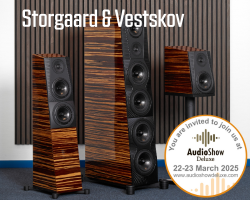SALTWOOD SOUNDS FINISTERRE LOUDSPEAKERS REVIEW
Saltwood Sounds Finisterre Loudspeakers are the creation of a small team based in Spain and the United Kingdom. They offer a small range of two floor-standing speakers and a portable Bluetooth speaker. In this review for HiFi PiG, Janine Elliot listens to their Finisterre floor-standing model costing £17,500.

Having seen pictures of, but not seen in the flesh, the Saltwood Sounds’ Finisterre floorstanders coming in at £17,500/pair, I was eager to put them through my hands and ears. Interestingly designed and beautifully curved they looked great in my living room when Neal Taylor, co-owner of the Pamplona-based Spanish manufacturer with an office in Cambridge, delivered them to my house in massive wooden cases. British Neal considers himself the language and business-focussed strategist who loves swimming and playing the guitar, with Kiwi-born Craig Thorburn, who specialises in yacht building – reflected in the design and shape of the Finisterre – doing the woodwork, and Dr Alastair Waugh, who masters in science and biochemistry, making up the rest of the team. They come together to combine physics and beauty in designing the loudspeaker. These last two live in Spain. Quite a mixture of backgrounds and something rather exciting for a new speaker cottage industry. Indeed, their ideas and beliefs about loudspeakers, that like good things in the past they should look good now, brings new light into an already over-populated world of loudspeakers. Like yacht-building, their ethos is of a timeless way of manufacturing. Nothing modern like carbon fibre or AI-designed boxes. This is pure physics and wooden boxes using two sheets of matched French Walnut at the front per speaker for strength with a Baltic Birch back, and 30mm Birch ply pieces glued together in between. And, if you don’t like the finish, they’ll use different wood at the front, or even make it in black or any other colour that matches your handbag.

HISTORY AT SEA
When they first started looking at speaker designs in 2021 they researched how speakers were made in the 1930’s and used this as the basics of their design. Their first speaker was a bookshelf speaker, followed by two BT speaker designs. As Alastair told me, the first was the Sargasso; “largest, with extended stroke woofer, ceramic tweeter and 2 x passive radiators, with a classic cross-over after the in-built amp”. Then came the Molucca, a smaller unit, with a sub-woofer and 2 x full-range drivers, which uses DSP upstream of the DACs and before the amplifier. “Molucca and Sargasso are names of seas for obvious reasons” Alistair told me. Interestingly, Finisterre comes from the Latin ‘Finis Terrae’ “Land’s End”, and used to be – as I very well remember from when I was closing down Radio 4 for the night in the good old Beeb days – one of the most rugged headland areas of the North Atlantic mentioned in the nightly shipping forecast before we played “Sailing By” by Ronald Binge to put everybody (except sailors) to sleep. Interestingly, the BBC changed its name to FitzRoy 10 years ago in memory of the person who set up the Met Office in 1854, because it was confusing sailors; whilst “Finisterre” covered a massive area of 90,000 square miles around the North-West of Spain, the Spanish also used the same name “Finisterre” to cover a significantly smaller part of this area around the municipality of Fisterra where there used to be a lot of shipwrecks. Apparently, Admiral Robert FitzRoy committed suicide 11 years later as he thought his forecasts weren’t preventing ships from sinking. In 2021, whilst surfing in the Basque country in France, and nearly drowning, Neil and Craig (woodworker) had a moment of reflection as to what to do that could be meaningful in their lives. So, whilst cooking stew and drinking beer next to the van, the idea of manufacturing loudspeakers was born. The word Saltwood is appropriate after their experience in the sea.




Whilst the two BT speakers sounded very exciting propositions, they would probably have been too expensive for that market, and when pitched to shops, these weren’t quite what was wanted. What was needed was a floor-stander, and after three development designs, the Finisterre became the fourth, or rather first, loudspeaker from Saltwood Sounds and was released to admiring visitors at the North West Audio Show at Cranage in June 2024. Using their love of sea, music, skills of wood building and background of science, the Finisterre was born. The curved shape not only reflects the building of ships, but they noticed at the show that visitors felt they had to caress the gorgeous curved shape! But this was not just for looks or affection of course, the curvature reduces the reflection of waves inside the unit and the highly braced and damped interior with a rectangular port at the bottom front keeps the unit very rigid, as does the plywood-looking composite construction of the sides.
BUILD QUALITY AND FEATURES OF THE SALTWOOD FINISTERRE
The build and construction of this loudspeaker is excellent, though the shape may not suit every room. This is a two-driver loudspeaker with an 8” aluminium-domed bass made by Purifi Audio which has ultra-low distortion up to its ultra-low crossover point at 1500Hz. This means that those essential vocal and string sources don’t get hindered by a wall of crossover frequency curves. I’m still a fan of single-driver speakers! As Alastair informed me, “Both filters are 12 dB….and the woofer has a series notch filter too, to treat some cone break up around 5kHz, without messing with the impedance, following a Purifi suggestion”. It certainly works. This is a long-stroke design to give plenty of deep bass and volume when needed and has an interesting suspension, with the surround undulating back and forth around the rim of the cone, like nothing else I’ve seen. A visitor to my house remarked “is this damaged?” I reassured him that this was a design feature. Indeed this is there to ensure that the surface area always remains constant wherever the cone is being pushed in or out, maintaining low distortion. An extra reinforcement ring around the inside the driver also aids lower distortion. These Danish drivers are not cheap, coming in at around £600 each. The Satori TW29B beryllium dome tweeter (also designed in Denmark, and manufactured in Indonesia) handles mids surprisingly well and extends up to 20,000Hz. The CCAW (copper-clad aluminium wire) voice coil ensures low moving mass. Whilst the tweeter front has protection against cats and kids, there is no front grille for the loudspeaker, which may concern some, but being nude not only improves sound quality and dispersion but also gives you a chance to admire the front Walnut. My only gripe on the sample I received (which is the same as on their website) is that I couldn’t really see the “matched pair” credentials. Mind you, this is just the review sample.
With an ideal impedance of 6 ohms, the loudspeaker is rated at 25-20,000Hz (+/- 3dB).
Each loudspeaker is very heavy, coming in at 40kg and overall dimensions are 90 x 30 x 40 cm (h/w/d). The black metal isolation stand at the bottom of the unit did cause arguments in design, though what they have settled for is, without doubt, the best idea, as it is fixed onto the unit with a hidden damping layer, 6 damping grommets, plus adjustable isolation metal feet with rubber rings below the base plate. There are no spikes here. Good. The Saltwood LEV System (Levitation & Elimination of Vibrations) is highly dampened, preventing vibration from or to the speakers, and whilst the unit can wobble if you try to tip it, it is extremely stable! The lower rear of the unit with a single pair of good quality sockets is assembled on a cleverly designed blue metallic square reflecting waves in the sea with the company name, logo and serial number, which looks very distinctive! This is a well-thought-out box, though if I have any quibbles, perhaps the rectangular port could be painted black inside or wood-stained.

SOUND QUALITY
When I spoke to the company at the start and told them my main amplifier is a KT88 based tube mono-block power-amp from Synthesis, it met with some concerns. This loudspeaker was designed whilst listening with a Purifi 2 x 200W Class-D amplifier, a very well-respected modular low-distortion amp manufacturer, as well as speakers. Like Hypex, these modules are used by a number of companies and HiFi buffs around the world, who simply add a power supply, etc, into their own box designs. As the company hadn’t designed the amp with valve amplifiers plugged in, the company were keen for results of my observations. So, after initial listening tests with the Synthesis, I agreed to use my Krell SS Class A power amp and a homemade (not by me, but by a very clever friend) Class D MOSFET amp in addition. These are low-sensitivity speakers coming in at around 86dB/m, but with the 80W valve combo the volume control needed a little more than 20% volume to give me loud enough music to satisfy my needs. Indeed, even with the Krell, the volume was around the same level. Dear Saltwood Sounds, these speakers sound fine with valve amplification in terms of powering to a high-level output, and, indeed, I found it quite a challenge to decide after all my listening which option of amplification was the best! More on that later. This loudspeaker worked with all classes and with all types of music, though I did feel that acoustic instruments and vocals made it stand out from many speakers around this price point. That said, £17,500 is a lot of money for a loudspeaker, especially for a first model, though never did I feel the price was unreasonable. Craig and Al have put together a very professional mid-size floor-stander, and I look forward to seeing and hearing their future larger 3 driver model when that comes out.
first of all, I decided to play music from the Netherlands with the Elles Springs ‘Reveal’ album from Vertere, wondering if my valve amplifier would reveal everything on tube that they told me it would only do on SS. Indeed, it was very detailed with a very extended bass end from the double bass, and with a very accurate and musical guitar and vocal, with good ambience in “Anyway”. Surprisingly, the Krell didn’t sound so good. In track 3 “This Ain’t no Game” (my favourite track from this album) there is a definite distortion in the recording at 01:00 and the track sounds highly compressed, and worse on the highly revealing and sounding Krell. Those lovely tubes in the Synthesis Roma 98DC can give out musical pleasing harmonics if pushed, whereas the Krell is a very clean, fast and unforgiving amp especially when combined with these very low-distortion speakers. So, even the clipped end decay of this track was more forgiving on the KT88 Synthesis. That said, the piano on this album and a number of other albums I played, was cleaner and more realistic on the Krell. The designing of pianos really depends on the wood used, especially the soundboard, and I wondered if the mixture of woods and building techniques in the Finisterre would hinder the musical qualities, but it really seemed to aid the overall musical sound produced. This is a very sturdy loudspeaker, like a ship, with very low distortion, particularly at the bottom end.




Still on valves, “Come Fly with Me” (Amsterdam Jazz Trio), as used in many of my reviews, just didn’t sound as “biting” and detailed as I have heard before, but speeded up once I used transistors. Cymbals were not as clean, and whilst piano was good (Jochem Braat), bass was a little muddy in places on the valve amp. Everything opened up on the Krell with a better top end and with “tighter” piano playing. Indeed, that top end was something I really needed to look into, as being used to adding a Townshend Supertweeter to the top with my own speakers, I obviously couldn’t do that whilst reviewing the Finisterre! Hence, my next performance, and on CD, was Derrin Nauendorf’s ‘Ghost Train’. Even on valves, nothing here was ghosting around; the Yamaha acoustic guitar was so tight and extended, showing off his excellent playing skills, and with a very fast bass drum added to the mix. Derrin’s soulful voice was also excellent and powerful, though on the solid state amp it just opened it up further and was cleaner and tighter. Even on my tiny homemade Class D amplifier, this was a good performance, though the bass extension on the valve amp was what I really enjoyed, giving lots of pressure on the kick drum on the 2nd and 4th beats.
Kate Bush’s Prelude from the 2018 re-mastered ‘Aerial’ with all the birds and pigeon sounds along with the child’s voice is very ethereal and fills the soundstage on most loudspeakers, but on the Finisterre on valves it wasn’t quite as 3D as I had become used to, though the overall soundstage was just behind the speakers. Hmm, I needed to explore this more as I really expected the speaker to be highly capable, so I turned to two brilliant albums to really test the soundstaging abilities. Firstly ‘Kitaro – Live in America’ recorded in 1990 during his world tour. A Japanese composer and performer specialising in electronica/New Age and Japanese instruments such as flutes and percussion, this album is from a live concert. This music has a great atmosphere, especially with the wind, thunder and other effects, so you could be convinced this was actually recorded in an open field at night. Rather, it was recorded at the Fox Theatre in Atlanta, Georgia. This very ethereal album has lots of space and a very Vangelis and Jean Michel Jarre new-age style. It starts very quietly but soon the rain and the thunder enter the venue making for a very atmospheric and very deep and powerful musique concrète performance through the loudspeakers, followed by deep Taiko drum beats and Japanese flutes and violins from this brilliant Japanese composer. His mix of real and synthesized sounds translates brilliantly through these speakers.

Turning next to a Chinese musician, sound artist and producer Dadawa and her aptly titled album ‘Sister Drum’, that speed of drum blasts – as low as 20Hz – were so clean and effective. You could feel the sound pressure in the room! Dadawa has even been a UNDP Goodwill Ambassador and set up “Sound Lab” at Shanghai’s Institute of Architecture and Design. These speakers could cope well with any sound design asked for, with both valve and transistor working with equal aplomb, both quietly and loudly when you wanted it. Bass end was more controlled on SS, and yes, those 8” cones are indeed long stroke!
Annie Lennox “Wonderful” was beautiful on both valve and solid-state, with great bass extension at the start, and the punchy chorus coming in at 1’40” was a lot more aggressive and with more detail on the Krell, showing well the inaccuracies of the recording. Playing loud rock and pop showed the speaker could work very hard and still be very detailed. This time valve was tops, smoothing the corners I guess. I had found in a lot of my listening that acoustic instruments and vocals were the speaker’s forte, especially when there is a big soundstage.
Turning to classics and Vivaldi’s ‘Four Seasons’ (‘Spring’ “Allegro”, “The Best of Vivaldi”) the amount of detail and musicality coming off these drivers and the way it all gelled in the cabinets was just so professional for a ‘first’ product. Whilst valve was very enjoyable, I have to admit it was the SS that just slightly had the edge, with the singing between the first and second violins far more effective and accurate on solid state. The valve, and this really is a good amp, just sounded a little too muddled for me. The instrumentalists, including solo violin and harpsichord all have their position in the soundstage making it easy to distinguish all that is going on and enjoy this brilliant work.
On reel to reel and Rimsky-Korsakov ‘Scheherazade’ (Chasing the Dragon, 15ips ¼”), the performance was so energetic and captivating when it needed to be, especially on the sea-faring movements such as The Sea and Sinbad’s Ship.
Moving to The Lyndhurst Orchestra and “The Battle of the Gladiator” added greater depth to the soundstage and a more exciting lower bass and guitars on the Krell. Indeed, I found this across all the music I played on the Krell through these speakers. Details were able to be played with an excellently low level of distortion and fast transients, such as the footsteps in John Lee Hooker’s “Deep Blue Sea” and the manual ADT on Kate Bush’s Aerial. It was very close between both tube and SS, but Alastair and the team, you are right, SS does work best. Whilst I am not a fan of Class D, it was surprisingly good too, but the Krell KAV 250a (“Krell Audio Visual”) is so much better than being classed as an AV amplifier.
CONCLUSION
This was always going to be an interesting review, not only for a first speaker, but because I was told it probably won’t work on valve. It really did well, though the speed and detail from solid state was what tipped the scales.
The drivers are brilliantly engineered, if looking a bit odd around the edges! Their speed and accuracy, combined with the Finisterre design and crossover, deserve an amplifier of equal speed and detail.
Sensitivity with all the amps was not an issue. Indeed, sometimes the volume control was lower on my valve than on the transistor. What is important is whether it sounds good with your HiFi setup, whatever that is, plus your musical and audio tastes. I would definitely recommend you take a listen for yourself at a show or at a store (see Saltwood Sounds website for more information).
With a mixture of Spanish, British, Danish, Kiwi, French and Baltic input, this turned out to be a very uncomplicated marriage, and I certainly don’t think there will be any stormy seas ahead for this company.
AT A GLANCE
Build Quality:
Beautiful and cleverly assembled, with excellent isolation stands
Sound Quality:
Excellent across all frequencies, with very extended and tight bass end
Value For Money:
At £17,500 this is not really for your starter HiFi system, though they worked brilliantly on all I attached to them. If you need good frequency extension and low distortion this is a very reasonable price
We Loved:
Focus and transparency
Bass extension
Low distortion
LEV isolation support
Good 3D soundstage
We Didn’t Love So Much:
The price point might worry some prospective purchasers.
Elevator Pitch Review: As a first product from a company and coming in at £17,500 this was an exciting opportunity for me to evaluate its strengths, and whilst I was told its weakness might be in using valve amps as the source, that was more of a reason for me to get even more captivated. With a trio of physicist, boat-builder, and guitarist as co-founders one might wonder not only what their first loudspeaker would sound like, but also what it would look like, but as this new company sets sail, I think their voyage looks highly promising.
Janine Elliot
System used:
Pre-Audio GL-1102N/Ortofon Kontrapunkt b (turntable/cartridge); Manley Steelhead (phono-stage); Krell KPS20i (CD); Ferrograph Logic7 (reel to reel); Music First Audio Baby Reference pre-amp, Synthesis Roma 98DC valve and Krell KAV250a SS (amplification); Tellurium Ultra Silver 2 and Townshend F1 cables, Coppice Audio stand and Townshend rack.
SUPPLIED SPECIFICATION
- Floorstander speaker with low resonance frequency of 25Hz.
- Frequency response: 25 – 20,000Hz (+/- 3dB)
- Impedance: 6 ohms
- Woofer: 8” Purifi Audio PTT8.0X aluminium cone
- Tweeter: Satori TW29B Beryllium
- Saltwood LEV Isolation platform
- Dimensions: 90/30/40 cm (h/w/d)
- Weight: approximately 40kg per unit
Merit-Based Reviews and Awards
At HiFi PiG, our reviews and awards are always free. No fees for reviews, no fees for the recognition we give.






















































































































































































